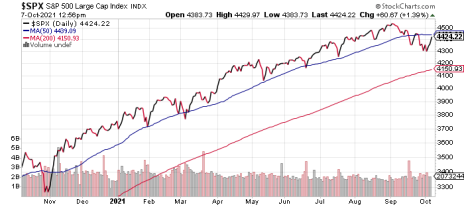September was, generally, a rough month for the major indices, with the Nasdaq declining 6% from the highs and the S&P down 5%. Broad market declines have been attributed to a spillover from tech-heavy growth stocks as well as increasing fears around inflation and increasing commodity prices as well as the potential for rising interest rates. Markets have rebounded nicely this week and recouped much of those declines, but whether this bounce signals a resumption of the uptrend is anyone’s guess. If you’re an option trader it might be worth exploring how to use a long-term options strategy to maintain a bullish position (if you’re so inclined) while muting the impact of short-term volatility.
The S&P 500 recently broke support at the 50-day moving average and is trading below the bullish range it’s enjoyed for most of the year; it’s no longer persistently setting higher highs and higher lows, but this may simply be a break in the intermediate-term trend that doesn’t compromise the long-term trend.
[text_ad]
Investors that remain bullish implementing a long-term options strategy could, hypothetically, purchase an in- or near-the-money January 2023 call on the SPDR S&P 500 ETF (SPY) for around $38, approximately 8.5% of the cost of the underlying investment.
A Cost-Mitigating Long-Term Options Strategy
We’ve written before about the risk mitigation aspects of using LEAPS (long-term equity anticipation securities) for a long-term options strategy, but there are also cost mitigation strategies you can implement. For instance, you could currently sell an out-of-the-money SPY call (against the underlying LEAP) with an expiration next month for $3-$5 (depending on how far out-of-the-money you’re planning to go).
In the event a bull market enters consolidation or becomes range-bound, selling out-of-the-money calls against an underlying call position can allow you to reduce your effective cost of the LEAPS contract. However, in the event that the bull market resumes prior to the expiration of the calls you’ve sold, you may be forced to buy those calls back to avoid having to exercise your underlying calls prior to their natural expiration. This typically won’t generate losses on the trade as your in-the-money LEAPS should have appreciated at the same rate as the now-in-the-money calls you’ve sold.
This type of bull call spread, where you have a mismatch in expiration months, is known as a diagonal spread, and is a frequently used long-term options strategy.
Contrary to what we’re seeing in the S&P, the Nasdaq is oscillating around its 50-day line (and has been for the last year). The tech-heavy index traded sideways for the first half of the year before resuming its uptrend in the summer. The intermediate-term trend is lower, despite positive action thus far in October but, again, we’re not in the prediction game (although a few more days of positive action breaking out of this downward channel would certainly be a bullish signal).
A Speculative Long-Term Options Strategy
LEAPS investors could engage in a speculative long-term options strategy by buying calls above the resistance level (if they’re bullish) or by buying puts at or below the recent lows (which appears to be near a convergence point of resistance in February and April and recent support). For the bullish investor, LEAPS offering exposure to the Invesco QQQ Trust (QQQ) above 380 (the price which coincides with the recent highs in the Nasdaq) with a January 2023 expiration are trading near $30, again, approximately 8% of the cost of the underlying investment.
Using LEAPS as part of a long-term options investing strategy can be an effective tool for managing short-term volatility either by reducing your costs, or by looking forward to significant price levels while also offering downside protection.
Is LEAPS trading part of your overall portfolio strategy?
[author_ad]



